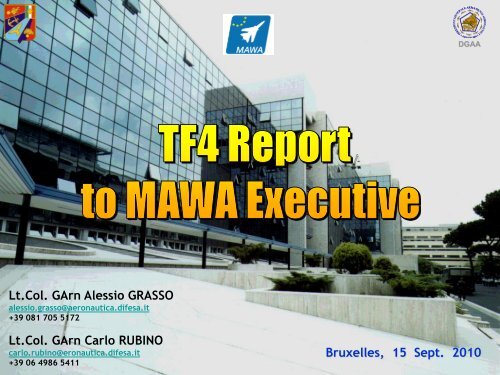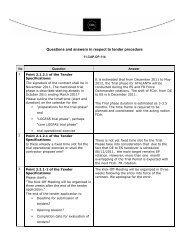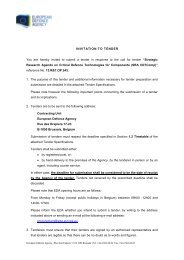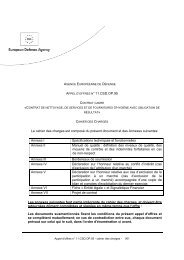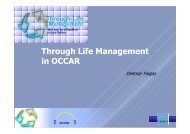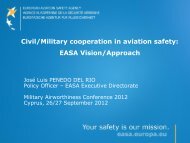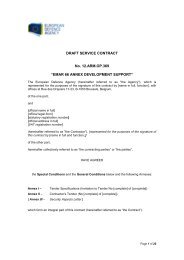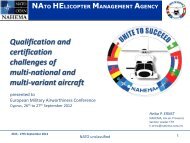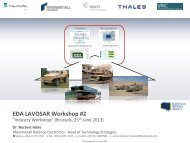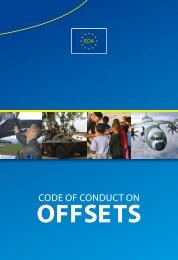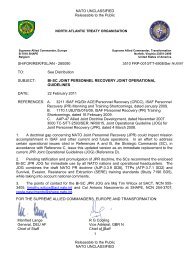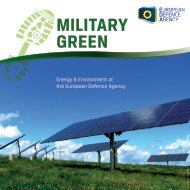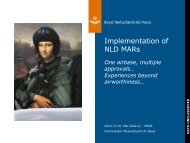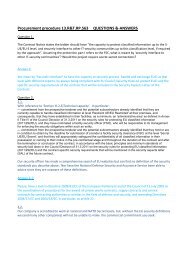10.ARM.OP.23 - MAWA TF4 Report
10.ARM.OP.23 - MAWA TF4 Report
10.ARM.OP.23 - MAWA TF4 Report
- No tags were found...
Create successful ePaper yourself
Turn your PDF publications into a flip-book with our unique Google optimized e-Paper software.
DGAALt.Col. GArn Alessio GRASSOalessio.grasso@aeronautica.difesa.it+39 081 705 5172Lt.Col. GArn Carlo RUBINOcarlo.rubino@eronautica.difesa.it+39 06 4986 5411Bruxelles, 15 Sept. 20101
PRESENTATION OUTLINEDGAAAIMTo report on progress with respect to deliverables of projectassigned to <strong>MAWA</strong> <strong>TF4</strong>:EMACC - European Military Airworthiness Certification CriteriaMAOD - Military Aircraft Occurrence Database2
TABLE OF CONTENTSDGAAEMACC - European Military Airworthiness Certification CriteriaMAOD - Military Aircraft Occurrence Database3
TABLE OF CONTENTSDGAAEMACC - European Military Airworthiness Certification CriteriaMAOD - Military Aircraft Occurrence Database4
TABLE OF CONTENTSDGAAEMACC - European Military Airworthiness Certification Criteria<strong>MAWA</strong> <strong>TF4</strong> - BackgroundEMACC Project MissionEMACC LOT 1 requirementsEMACC deliverables D1 and D25
<strong>MAWA</strong> <strong>TF4</strong> BACKGROUND (1/2)DGAA• 09/03/11 <strong>MAWA</strong> F02 MEETING [BRX]‣ Decision to create <strong>MAWA</strong> <strong>TF4</strong> with the task to developmilitary certification codes/standards and safetyrequirements.• 09/06/05 <strong>MAWA</strong> AW WORKSHOP [OLOMOUC – CZ]‣ Decision to establish the European Military AirworthinessCertification Criteria to be used in the determination ofmilitary weapon systems’ airworthiness.6
<strong>MAWA</strong> <strong>TF4</strong> BACKGROUND (2/2)DGAA• <strong>MAWA</strong> <strong>TF4</strong> HISTORY‣ <strong>TF4</strong> KOM (Naples, 12 August 09)‣ Established <strong>TF4</strong> Roadmap‣ Developed technical specificication requirement for EDA LOT 1(EMACC)‣ EDA LOT1‣ EDA called for tender (Oct 09)‣ FRAZER-NASH CONSULTANCY LTD awarded EDA LOT 1CONTRACT (Dec 09)‣ <strong>TF4</strong> Technical Meetings‣ <strong>TF4</strong>#2 Brussel (20-21 Jan 2010)‣ <strong>TF4</strong>#3 Brussel (22 March 2010)‣ <strong>TF4</strong>#4 Estoril (25 May 2010)7
EMACC PROJECT MISSIONDGAA• To investigate the feasibility of producing harmonised militaryairworthiness certification criteria.• The main objective is the development of:– A European equivalent of MIL-HDBK-516B, intended to beused to tailor the airworthiness basis for military weaponssystem in order to achieve Military Type Certification[Deliverable D1]– The sub-set of harmonised structural airworthiness criteriawithin the equivalent MIL-HDBK-516B document[Deliverable D2]8
EMACC LOT 1 REQUIREMENTSDGAAMain Deliverables• Deliverable D1To provide a complete equivalent MIL-HDBK-516B document thatpoints to the existing military (JSSGs, Def-Stan 00-970, STANAGs)and civil standards covering all the certification criteria.• Deliverable D2Harmonised structural airworthiness criteria within the equivalentMIL-HDBK-516B document along with a program plan and costestimate to harmonise all the criteria.9
DELIVERABLE D1DGAA•Approach– MIL-HDBK-516B startingpoint– DOORs database withexisting 516B criteria, USDoD/Mil and FAA crossreferencesMIL-HDBK- 516BExisting USInformationDeliverable D1European Equivalent MIL-HDBK- 516BExisting USInformationMissing Euro Information– Identify cross-references toEuropean documents whereequivalence is deemedpossible:• Def Stan 00-970• STANAGCriteriaUS DoD/Mil Cross ReferenceFAA Cross ReferenceCriteriaUS DoD/Mil Cross ReferenceFAA Cross ReferenceDefStan 00-970 Cross ReferenceJSSG Cross ReferenceSTANAG Cross ReferenceEASA Civil Standard Cross Reference• JSSG• EASA CS10
DELIVERABLE D1DGAAProgress to Date– Kick Off meeting with <strong>TF4</strong> on 20 th January 2010– Conceptual <strong>Report</strong> issued, including scope of work andapproach for Deliverable D1 agreed with <strong>TF4</strong>– Scoping exercise completed (Feb-March 2010)• MIL-HDBK-516B imported into DOORs• Format of Deliverable D1 confirmed with <strong>TF4</strong>– Submission of Deliverables for Review• March, 31 stSection 9 of MIL-HDBK-516B delivered to <strong>TF4</strong> for review -work completed - agreed• June 30, thComplete sections 5, 7, 11, 12 and 13 of MIL-HDBK-516Bdelivered to <strong>TF4</strong> for review - work on progress11
DELIVERABLE D1DGAAPlan moving forwards– Population of DOORs database• Present through to October 2010• Quarterly reviews with <strong>TF4</strong> (September, December)– Draft EMACC Study <strong>Report</strong>• November 2010– Final EMACC Study <strong>Report</strong>• December 201012
DELIVERABLE D2DGAAApproach– Deliverable D1 starting pointMIL-HDBK- 516BExisting USInformationDeliverable D1European Equivalent MIL-HDBK- 516BExisting USInformationMissing Euro Information– Text Harmonisation of selected MIL-HDBK-516B Lines (5.1, 5.3, 5.4)against the following references:• Def Stan 00-970• STANAG• JSSG• EASA CSCriteriaUS DoD/Mil Cross ReferenceFAA Cross ReferenceCriteriaUS DoD/Mil Cross ReferenceFAA Cross ReferenceDefStan 00-970 Cross ReferenceJSSG Cross ReferenceSTANAG Cross ReferenceEASA Civil Standard Cross ReferenceDeliverable D2Harmonisation of SelectedSystem within Deliverable D1– Provision of Risk Reduction <strong>Report</strong>for remainder of MIL-HDBK-516B interms of:• Programme Plan• Cost EstimateRisk Reduction <strong>Report</strong>Programme PlanCost EstimateFollow-onProgrammeEMAG HarmonisedMilitary AirworthinessCertification Criteria13
DELIVERABLE D2DGAAProgress to date– Submission of Drop 1 Deliverable for Review• 5.4 Lines (Damage tolerance and durability - fatigue)submitted on 31 st March 2010• 5.4 Lines reviewed during <strong>TF4</strong>#3 meeting where it wasagreed the first EUROPEAN HARMONIZED TEXT FORFATIGUE REQUIREMENT– Submission of Drop 2 Deliverable for Review• 5.1 and 5.3 (Loads and Strength) submitted on 30 th June2010 for review during next <strong>TF4</strong>#4 meeting (TBD).– Progression of Project Deliverables• Drop 3 will be submitted by 30 th September14
TABLE OF CONTENTSDGAAEMACC - European Military Airworthiness Certification CriteriaMAOD - Military Aircraft Occurrence Database16
<strong>MAWA</strong> <strong>TF4</strong> MAOD BACKGROUNDDGAA• 09/06/05 <strong>MAWA</strong> AW WORKSHOP [OLOMOUC – CZ]‣ Reccomendation to establish the exchange of information onaccidents/occurences amongst European Military Authorities(all aircraft types).‣ EDA LOT 3‣ EDA CALLED FOR TENDER (OCT 09)‣ AVIATION WORKS INTERNATIONAL AWARDED EDA LOT 3CONTRACT (DEC 09).‣ <strong>MAWA</strong> F05 MEETING (Brussels, 20-21 Jan 10)‣ <strong>TF4</strong> TASKED TO MANAGE THE LOT 3 ACTIVITY‣ <strong>MAWA</strong> <strong>TF4</strong> MAOD KOM (Naples, 15-16 Feb 10)‣ <strong>MAWA</strong> <strong>TF4</strong> MAOD #2 (Naples, 2 Sep 10)17
EDA <strong>MAWA</strong> LOT 3 - DeliverablesDGAAD1 – a Feasibility study that points to existing civil and militarydatabases standards and lessons learned, including militaryspecific criteria.D2 – a demonstrator of MAOD with pilot nations (*) todemonstrate on examples the feasibility and acceptance ofthe responsible national authorities.The demonstrator shall be functional and accessible forresponsible authorities via webpage.(*)18
MAOD Project ApproachDGAAINPUTS TO PROJECTReview and Agree the scope and objectivesINTEGRATIONAs a team, bring together allinputs to develop thefeasible solutions for <strong>MAWA</strong>DeliverablesMapping the Existing Situation-Assess the Current Military Frameworktowards Civil Framework- Review and define <strong>MAWA</strong> detailedrequirement (possible interviews tocapture the view of key experts)MAOD Feasibility Study1Influencing FactorsDefine MAOD requirements-Viability Analysis-CAB Analysis-….2MAOD DemonstratorMAOD Implementation Strategy Plan-Benefits-Shortfalls19
DELIVERABLE D1DGAAApproach– Analysis of existing Europeanoccurrence reporting systemimplemented by EASA throughofficial documents.– Interview/ questionnaire submittedto the Military National AviationFlight Safety Authorities in order todelineate the current situation.– MAOD Basic structure will bedeveloped using as a reference EC42/2003 implemented as necessarywith “military delta requirements”extracted from questionnairefeedback.20
DELIVERABLE D1DGAAQUESTIONNAIRE RESULTS• 16 pMS compiled the MAOD QuestionnaireAUSTRIABELGIUMBULGARIAEDAESTONIAFINLANDFRANCECZECH REPUBLICGERMANYGREECEPORTUGALSLOVAKIAHUNGARYLATVIAITALYSWEDENUNITED KINGDOM21
DELIVERABLE D1DGAAQuestionnaire Results• All the pMS run an effective OR system, but each of themimplemented their own regulatory.• <strong>Report</strong>ing attitude is different, as shown by the rate of “reportsper hour flown”, that is expected to be similar, but is not.• ATC data collection seemed to be not fully developed: manynations do not use it.• Maintenance error data collection is implemented by most of thecountries.• Most of the nations issue at least a yearly report regarding datacollected.• The structure national Flight Safety organization appears verysimilar (squadron-wing-central unit).• Most of the Countries are available to share data with EDA;anyway some of them clearly said “NO”.22
DELIVERABLE D1DGAAPerceived gaps and barriers1. Different standardization among National Military Aviationsregarding the Flight Safety2. Different reporting attitude3. Lack of ATC reports4. Availability to communicate data such as flight hours, A/Cdata, mission flown5. Language6. Training of personnel to standard compiling and datahandling7. Lack of availability [or willingness] for cooperation betweenpMS23
DELIVERABLE D1DGAAPreliminary feasibility study results1. The implementation of a MAOD is feasible within a realistictime scales, that can be estimated as early as four yearsfrom the start up.2. To achieve effectively a full implementation of a MAOD isnecessary to involve actively all the pMS, principally fromwhich of them that have in place an ORS since a long time;they can be the trend setters, able to share theirexperience in Occurrence <strong>Report</strong>ing and promote, withinthe future EMJAAO, these concept to the other countries.24
DELIVERABLE D1DGAAPreliminary feasibility study reccomendations1. <strong>MAWA</strong>/EMJAAO should issue a set of recommendedguidelines2. Develop a standardised form for proper data collection3. Set minimum requirements for organisationSquadronWingNationLocal Users(feeder)Flight Safety Officer(analyser)Flight Safety Supervisor(national user)25
DELIVERABLE D2DGAAApproachFSoutputsSW DEVELOPMENTDEMONSTRATORRELEASE<strong>MAWA</strong> <strong>TF4</strong> & AWIWEB BUGREPORTING26
DELIVERABLE D2DGAA• The MAOD demonstrator architecture will follow the followingflow scheme:27
DELIVERABLE D2DGAAA. The MAOD architecture will foresee a single databasepartitioned for each pMS, represented by a provisionalstorage (PS). This will allow pMS authority to select the datawilling to be shared within the database authorized usersonly.B. The MAOD database will cover three areas: 1) A/C technicaldefects/maintenance, 2) ground and navigation services and3) Flight Ops.C. The MAOD should be flexible and it was agreed that thestarting point will address mainly the A/C technicaldefects/maintenance area.28
DELIVERABLE D2DGAACurrent release is alpha.3 and is available on line athttps://awi.vbelectronics.it/maod-alpha-329
DGAALt.Col. GArn Alessio GRASSOalessio.grasso@aeronautica.difesa.it+39 081 705 5172Lt.Col. GArn Carlo RUBINOcarlo.rubino@eronautica.difesa.it+39 06 4986 5411Brussels , 15 Sept 201030


